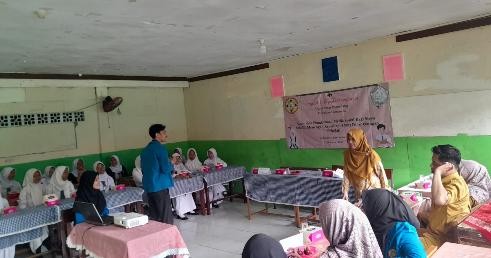Social media wise education: Improving the digital literacy of vocational school students through Instagram
DOI:
https://doi.org/10.53088/penamas.v5i2.2012Keywords:
Social Media, visualization, instagramAbstract
The COVID-19 pandemic has led to significant changes in the education system, including in Indonesia, with the implementation of online learning. This condition has encouraged an increase in internet and social media use among teenagers. Student activities on social media, especially Instagram, have increased significantly, but have not been balanced with adequate digital literacy skills. This Community Service activity aims to provide education to students of SMK Islamiyah Serua Ciputat about the wise and responsible use of social media, as well as encourage the involvement of teachers and parents in the online mentoring process. The implementation method includes initial observation, interactive counselling, positive Instagram content visualisation training, and practical assistance involving lecturers, teachers, and students. The results of the activity showed that students experienced an increase in understanding related to social media ethics, skills in creating positive content, and awareness of the importance of critical thinking before sharing information on social media. Additionally, teachers and school staff play an active role in supervising student activities both during and after the event. This program is expected to be the first step in forming a smart, critical, and responsible digital generation on social media.
References
Ahmad, I. (2019). The Most Popular Social Media Plat-forms of 2019. Retrieved April 8, 2018, from https://www.digitalinformationworld.com/2019/01/most-popular-global-social-networks-apps-infographic.html
Bennett, W. L., & Segerberg, A. (2011). Digital media and the personalization of collective action: Social technology and the organization of protests against the global economic crisis. information, communication & society, 14(6), 770-799. https://doi.org/10.1080/1369118X.2011.579141
Frison, E., & Eggermont, S. (2016). Exploring the relationships between different types of Facebook use, perceived online social support, and adolescents’ depressed mood. Social Science Computer Review, 34(2), 153-171. https://doi.org/10.1177/0894439314567449
Kaplan, A. M., & Haenlein, M. (2010). Users of the world, unite! The challenges and opportunities of Social Media. Business horizons, 53(1), 59-68. https://doi.org/10.1016/j.bushor.2009.09.003
Kuss, D. J., & Griffiths, M. D. (2017). Social Networking Sites and Addiction: Ten lessons learned. International Journal of Environmental Research and Public Health, 14, 311. https://doi.org/10.3390/ijerph14030311
Livingstone, S., Haddon, L., Görzig, A., & Ólafsson, K. (2011). Risks and safety on the internet: the perspective of European children: full findings and policy implications from the EU Kids Online survey of 9-16 year olds and their parents in 25 countries. EU Kids Online, Deliverable D4. EU Kids Online Network, London, UK.
Mauludin, M. A. (2017). Cerdas Dan Bijak Dalam Memanfaatkan Media Sosial Di Tengah Era Literasi Dan Informasi Di Kecamatan Cilaku Kabupaten Cianjur Propinsi Jawa Barat. Dharmakarya: Jurnal Aplikasi Ipteks untuk Masyarakat, 6(1), 1-4. https://doi.org/10.24198/dharmakarya.v6i1.14751
Nasrullah, R., Aditya, W., Satya, T. I., Nento, M. N., Hanifah, N., Miftahussururi, & Akbari, Q. S. (2017). Materi Pendukung: Literasi Digital. Jakarta: Kementerian Pendidikan dan Kebudayaan.
O’Keeffe, G. S., & Clarke-Pearson, K. (2011). The impact of social media on children, adolescents, and families. Pediatrics, 127, 800-804. http://doi.org/10.1542/peds.2011-0054
Pew Research Center. (2018). Teens, Social Media & Technology 2018. http://www.pewinternet.or/2018/05/31/teens-social-media-technology-2018
Rahmatulloh, R., Wardana, A. K., Sobahri, M., Syaban, R. F., & Laksana, A. (2024). Etika berkomunikasi di media sosial: Perspektif generasi Z. Studi Administrasi Publik dan Ilmu Komunikasi, 1(4), 44-50. https://doi.org/10.62383/studi.v1i4.52
Satyadewi, A. J., Hafiar, H., & Nugraha, A. R. (2017). Pemilihan akun media sosial Instagram oleh Holiday INN Bandung. Jurnal The Messenger, 9(2), 153-162. https://doi.org/10.26623/themessenger.v9i2.459
Setiawan, R. A., & Setyohadi, D. B. (2017). Analisis Komunikasi Sosial Media Twitter sebagai Saluran Layanan Pelanggan Provider Internet dan Seluler di Indonesia. Journal of Information Systems Engineering and Business Intelligence, 3(1), 16. https://doi.org/10.20473/jisebi.3.1.16-25
Suryani, I. (2014). Pemanfaatan media sosial sebagai media pemasaran produk dan potensi Indonesia dalam upaya mendukung ASEAN community 2015.(Studi Social media marketing pada twitter kemenparekraf ri dan facebook disparbud provinsi jawa barat). Jurnal komunikasi, 8(2), 123-138. https://doi.org/10.20885/komunikasi.vol8.iss2.art2
Twenge, J. M., Joiner, T. E., Rogers, M. L., & Martin, G. N. (2018). Increases in Depressive Symptoms, Suicide-Related Outcomes, and Suicide Rates Among U.S. Adolescents After 2010 and Links to Increased New Media Screen Time. Clinical Psychological Science, 6(1), 3-17. https://doi.org/10.1177/2167702617723376
Universitas Negeri Malang. (2020). Education guide 2020. https://um.ac.id/wp-content/uploads/2021/04/Education-Guide-2020.pdf

Downloads
Published
How to Cite
Issue
Section
License
Copyright (c) 2025 Marissa Ulfa, Metha Lubis

This work is licensed under a Creative Commons Attribution-ShareAlike 4.0 International License.
Authors who publish with this journal agree to the following terms:
The author(s) retain copyright and grant the journal the right of first publication with the work simultaneously licensed under a CC BY-SA 4.0 license that allows others to remix, adapt, and build upon the work even for commercial purposes, as long as they credit the author(s) and license their new creations under the identical terms.
License details: https://creativecommons.org/licenses/by-sa/4.0/


